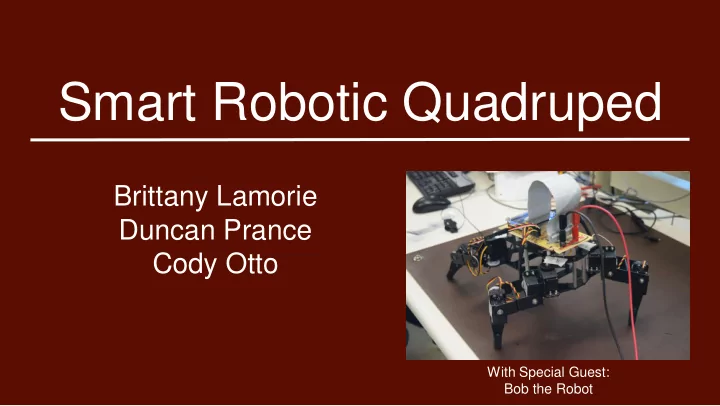

Smart Robotic Quadruped Brittany Lamorie Duncan Prance Cody Otto With Special Guest: Bob the Robot
Motivation Goals • • Interest in robotics and machine Build working robot learning • Create accurate simulation • Walking is an interesting of physical robot challenge • Convert simulation output to • ECE 449 Intelligent Systems pulse width signals • Hard-code basic motions • Learned walking motion • On board adjustments
Overview Design Plan • Simulation is run; All learning done on PC • Simulation outputs are converted to pulse width signals • Pulse widths are saved in memory • On board program reads pulse widths
Overview Current Functionality • Hardcoded Modes - Walk - Dance - Weight Shift - Simulation • Simulation output conversion • Battery powered tether
Simulation • Simulation used a combination of ODE and OpenGL for physics simulating, and PyBrain for the machine learning aspect • The machine learning uses a reward based system, allowing for fine tuned control over learned motion • The simulation is taught through a combination of neural networks and reinforcement learning
Simulation Trial 1 Trial 740 Trial 10500 Trial 20000
Pulse Width Modulation • Square wave form • Defines the angle of the servo motor
Converting from Simulation to Real World • Slippage between gears • Varying pulse width ranges • Rotation around differing points • Degree conversion for ease of use
Robot motion versus simulation motion
Learning to Walk Again….. • The stances shown allow for a total weight shift from front to back legs and back again • 3 point balance allows for a large safety margin for the torque of our servos
Learning to Walk Again….. • Simulated and exaggerated weight shifting was necessary to allow for balance during steps
DEMO
Challenges • Physical calibration • Math and precision • Simulation reward system to achieve a proper forward motion
Questions?
Recommend
More recommend